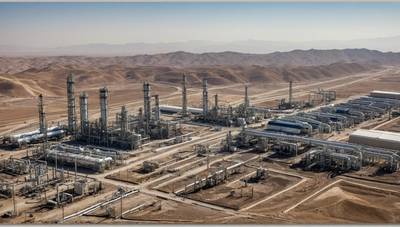Overview of Iran's major gas fields and oil infrastructure
Israel attacked an installation in Iran's South Pars Gas Field on Saturday. This was the first attack against Iran's oil-and-gas sector, as part of a long-term operation that the Israeli government warned would take place to stop Tehran from developing an atomic bomb.
Iran has temporarily suspended gas production at the South Pars Field, Iran's share of the world's biggest natural gas reserve. The field is located beneath the Gulf, and it's shared with Qatar, a major gas exporter.
Iran reported that Israel had also attacked a fuel depot in Tehran and an oil refinery close to the capital, but the authorities claimed the situation was now under control.
Here are some facts about the energy industry of the country, its exports and the impact on previous Western sanctions.
The World's Largest Gas Reserve
Iran produces natural gases from the South Pars offshore gas field. This gas field makes up about a third the world's biggest reservoir of natural.
Qatar, a major gas exporter, shares the reservoir with Iran. Qatar calls their field North Dome.
Due to technical and sanctions constraints, the majority of gas produced by South Pars is used for domestic consumption in Iran.
According to the Gas Exporting Countries Forum (a grouping nations that export gas), Iran's total production of natural gas in 2023 was 266.25 bcm. Domestic consumption accounted for 255.5 bcm.
The Forum reported that 15.8 billion cubic meters of natural gas was exported.
The attack on Saturday targeted four units in Phase 14 of South Pars. This is around 200 km from Qatar's major gas installations. Many of these are joint ventures between Qatar and international energy giants such as ExxonMobil, ConocoPhillips, and other U.S. companies.
Doha has been exporting LNG to the global market for almost three decades and made hundreds of millions of dollars.
The reservoir is estimated to contain 1,800 trillion cubic foot of gas, enough to meet the world's energy needs for 13 or 35 years.
SANCTIONS AND OPEC
According to OPEC, Iran's oil output peaked in the 1970s. The record production of 6,000,000 bpd was achieved in 1974. This was more than 10% world production at the time.
The first round of U.S. sanctions against Tehran was imposed in 1979. Since then, the U.S. has imposed several waves of sanctions on the country.
After Trump pulled out of a nuclear agreement during his first term as president, the U.S. tightened its sanctions in 2018. Iran's oil sales fell to near zero in some months.
Analysts say that sanctions were not enforced as rigorously and Iran was able to evade them.
Iran is exempted from OPEC+ production restrictions.
Who is the main buyer of Iranian oil?
Iran's crude oil exports reached a record high of 1.8m bpd, the highest level since 2018. This was largely due to strong Chinese demand.
China claims that it does not recognize sanctions against its trading partners. China's private refiners are the main buyers of Iranian crude oil. Some of these companies have been recently placed on the U.S. Treasury sanction list. However, there is little evidence that the sanctions have had a significant impact on Iranian oil flows to China.
Iran has been evading sanctions for years by hiding satellite positions and transferring ships from one vessel to another.
PRODUCTION and INFRASTRUCTURE
Iran is the third-largest producer of crude oil in the Organization of Petroleum Exporting Countries. It also produces 1.3 million barrels of condensate per day and other liquids. This amounts to about 4.5% of the global supply.
According to Kpler it exported about 1.8m bpd in crude and condensate, which is close to the peak of 2018. The remainder of production was processed in its domestic refineries, with a capacity of 2.6m bpd.
Kpler reports that in May, the country exported LPG and oil products worth 750,000 bpd.
According to FGE the country produces 34 billion cubic foot of gas every day. This is 7% of world production. The gas is used exclusively in the domestic market.
Iran's hydrocarbon facilities are concentrated mainly in the southwest. For oil, they are located in the Khuzestan Province and for gas and condensate produced from the South Pars Field in Bushehr.
Kharg Island is the main port of export for 90% of its crude oil.
Analysts believe Saudi Arabia and the other OPEC countries could compensate for a drop in Iranian oil supply by pumping more. Despite this, the spare capacity of the producers is being strained as they are currently raising their output targets.
(source: Reuters)







